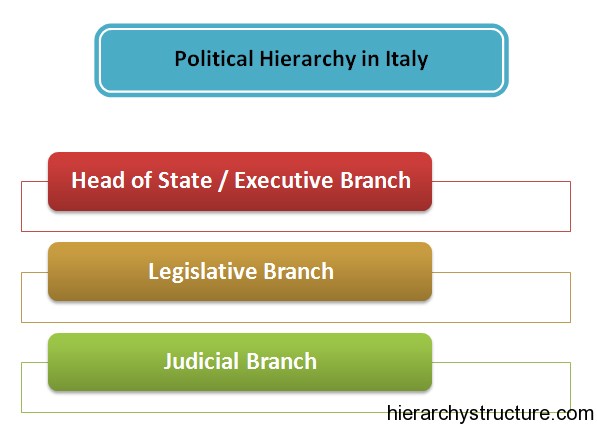The political system of Italy is a multi-party parliamentary democratic republic system. the political hierarchy has been exercising a democratic system since 1946 after abolishing monarchy by a popular referendum. The political hierarchy of Italy comprises of the following levels:

Head of State / Executive Branch
On the topmost level lies the Head of State, that is , the President of the country. A president is elected for a term of seven years with the majority vote in the parliament of 58 regional delegates. This level is also known as the executive branch of the political hierarchy. The responsibilities of President include heading the armed forces and overlooking the working of Parliament & the entire country.
The President also gets certain privileges like power to dissolve parliament, call elections and of veto legislations. President being the head of state is responsible for many tasks &duties which were earlier attended by the king. The president also acts as the single point of contact or connection between the Judiciary, Executive and the Legislative branch. The President is also required to act as the guardian of the Italy’s constitution.
Legislative Branch
The legislative branch of the country deals with law making and drafting responsibility. This is the second level in the political hierarchy of Italy. The legislative branch is sub divided into sections, namely, Parliament, Italian Senate and Italian Chamber of deputies.
The Italian chamber of deputies is the lower house of the Italy’s political system which is constituted by 630 elected members from a total of 26 constituencies of the country. These members are elected for a term of 5 years but President holds the right to dissolve the Parliament in case the members are unable to establish stable government.
The Italian Senate is also a bicameral Italian parliament house. It consists of 315 members elected by the citizens of Italy who are 25 years of age or above. This Parliament house also includes few Senators that are Senators for life. These members are the formal presidents of the country. The members of the Senate are elected for a term of 5 years and it can also be dissolved by the President under few circumstances.
Judicial Branch
The third level in the hierarchy is the judicial branch. the judicial branch of Italy find its roots in the Napoleonic codes, statues and the roman law. It is a combination of Inquisitorial civil law and adversarial civil law system. Here the Adversarial system has been adopted for appeal courts since 1988.
The constitutional court of Italy comprises of the 15 judges out of which one of the judge is the President of the constitutional court of Italy who is elected by the members of the court itself. One third of the judges are elected by the Parliament, one third appointed by the President of the country and rest one third are elected from the administrative and ordinary supreme courts of the country.
Know more about Italy Education Hierarchy Click Here
